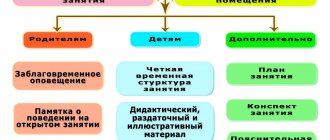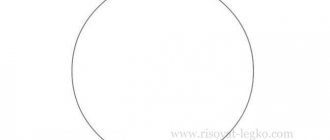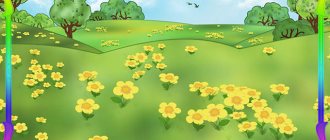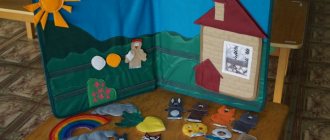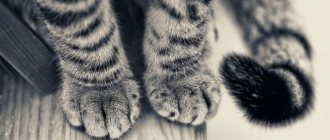Construct based on the theatrical game “The Three Little Pigs” under the direction of Lyudmila Petrovna Temereva
Age group:
middle group (4-5 years)
Kind of activity:
theatrical activity
Subject:
theatrical game "The Three Little Pigs"
Form of organization:
group
Planned result:
Children negotiate in the process of distributing roles and planning play space;
Children show interest in theatrical play;
Children cooperate in the process of implementing the game plan;
Children perform simple performances based on familiar literary works: “The Three Little Pigs.”
Target:
developing children's skills for joint play activities
| Tasks | Tasks taking into account the characteristics of the group’s students |
| Educational tasks : Develop the ability to negotiate in the process of distributing roles and planning the playing space; Develop self-confidence and positive self-esteem in the process of joint gaming activities. Developmental tasks: Continue to develop and maintain children’s interest in theatrical play by acquiring more complex skills; Training tasks: Teach children to perform simple performances based on familiar literary works: “The Three Little Pigs”; To develop the ability to cooperate in the process of implementing a game plan. |
Principles of preschool education (FSES DO):
- full-fledged experience by the child of all stages of childhood (infancy, early and preschool age), enrichment (amplification) of child development;
-building educational activities based on the individual characteristics of each child, in which the child himself becomes active in choosing the content of his education, becomes a subject of education (hereinafter referred to as individualization of preschool education;
-formation of cognitive interests and cognitive actions of the child in various types of activities; age adequacy of preschool education (compliance of conditions, requirements, methods with age and developmental characteristics).
Principles of education:
creating a positive emotional uplift, developing a personal style of interaction with peers and teachers, education through interaction.
Game equipment:
-a book of the fairy tale “The Three Little Pigs”, figures of game characters (three little pigs, a wolf), attributes (houses for piglets, trees), cards for drawing lots (4 cards of fairy tale heroes, 6 cards with a chair).
Game roles:
pig Nif-Nif, pig Naf-Naf, pig Nuf-Nuf, wolf
Preliminary work:
Reading the fairy tale “The Three Little Pigs.”
Educational and methodological kit:
Federal state educational standard for preschool education. / Ministry of Education and Science of the Russian Federation, order dated October 17, 2013 N 1155.
Progress of the lesson
Look how many guests we have today, let's say hello to them and give each other a good mood with our smiles. Today I am not just a teacher, I am a Sorceress, I have a magic wand that will help you go on a fabulous journey . Today you will be my assistants, and together we will tell and show a fairy tale for our guests .
If a fairy tale knocks on the door ,
Hurry up and let her in
You'll get a little scared and won't find it.
And to find out what fairy tale we will show today , you must guess the riddle.
The nose is round with a snout, it is convenient for them to rummage in the ground,
Guess without a hint who the heroes of this fairy tale ?
You already know this , and I hope you love it. Its heroes are little pink piglets .
-What is the name of this fairy tale ? (Three piglets )
This is an English fairy tale , it was translated from English by Sergei Mikhalkov so that we could read it.
Let's remember the plot of the fairy tale .
Once upon a time there lived three little pigs , NIF-NIF, NUF-NUF and NAF-NAF. In the summer they had fun, ran and played. I suggest you close your eyes and imagine a cheerful summer, where you enjoy the sun, butterflies, and flowers!
But everything ends, and autumn replaced summer, and the piglets became cold .
- Let's show how cold they were! Amazing!
— The piglets decided to build their own houses! Let's remember which ones?
- Now let's see if you named them correctly
-What is the house made of? (what kind of house: light, yellow, straw)
. How can it sway in the wind? Get up from your chairs, show me!
- What is this house made of? (Made from branches, fragile, cold, full of holes)
Let's show how unstable he is!
- What kind of house is NAF-NAFA, describe it? Please stand up and hold your hands tightly. A strong, strong house!
- Let's imagine how the brothers built their houses! From straw, from branches, from bricks or stones!
- The brothers built their houses and began to have fun again! And who do you think they woke up? Of course, a wolf! What kind of wolf?
Let's show an angry, scary, hungry, dangerous wolf!
Look at each other to see who has the scariest wolf!
- clicks his teeth, grins terribly;
- rolls his eyes, frowns his eyebrows;
— he puffs out his cheeks, almost bursting with hatred.
And now we smile at each other. Well done!
Now let's show how scared the piglets !
— they shrank into a ball and froze;
- eyebrows raised;
- our eyes are wide open, we are afraid to breathe and move;
- the head was pulled into the shoulders;
- they trembled, their teeth chattered;
- we can’t say
The wolf rushed after the piglets ! And the piglets ran to their houses!
Which house did the wolf run to first? What did he start doing? Children's answers. Let's blow like a wolf together, inhale air through our nose and exhale through our mouth! Now with me! Did the wolf break the house? And the younger brother hid in the house of the middle one !
also broke under the stronger ! Show me how it broke? Very good!
Where did the brothers run? But the third house stood, even though the wolf blew on it with all his might!
What did the wolf do then? Children's answers...
The piglet opens the cauldron , and the wolf falls into it, gets burned, and runs away!
3. Dramatization of children's fairy tales together with the teacher
I turn Maxim into a wolf!
They twirled, twirled, and turned into fairy tale .
Now, I ask you to get up from your chairs and go to our magical stage like real actors! And now I will read, and you show your heroes here...
Guys, how can it be that the wolf will fall and get burned. Don't you feel sorry for him? Since I am a sorceress, I will make him kind and friendly! The piglets will come out of the house to the wolf, hold hands with him and they will become friends! They will dance together
heroes perform a dance
Let's clap for each other.
Now I am turning you into children again. Sit on the chairs.
-Did you like our performance?
-What did you especially like?
-If you are in a good mood now, please smile!
Thank you all very much, and now we will say goodbye to our guests.
Summary of an integrated lesson in the middle group on the fairy tale “The Three Little Pigs.”
Summary of an integrated lesson in the middle group
based on the fairy tale "The Three Little Pigs".
Priority educational areas: “Communication”, “Artistic creativity”.
Integrated educational areas
: “Reading fiction”, “Communication”, “Artistic creativity”, “Socialization”, “Cognition”.
Tasks:
— Continue to enrich and activate children’s vocabulary, teach them to form adjectives from nouns, consolidate and clarify the meanings of words.
— Reveal knowledge of primary colors.
— Teach children to reflect simple drawings, convey the characteristic features of objects, and arrange them beautifully on a sheet of paper.
-To strengthen the ability to draw straight lines in different directions, to paint over drawings by applying strokes in one direction.
- Cultivate interest in creativity.
- Cultivate diligence, hard work, curiosity.
Preliminary work:
reading the fairy tale “The Three Little Pigs”; viewing illustrations; conversation.
Methods and techniques:
visual, verbal, showing, practical.
Materials and equipment
: illustrations for the fairy tale “The Three Little Pigs”, musical accompaniment, portrait of Sergei Vladimirovich Mikhalkov, cut-out pictures based on the fairy tale “The Three Little Pigs”, piglet dolls (table theater), albums, colored pencils, samples of the houses of the Three Little Pigs, book illustrations.
Progress of the lesson:
The teacher asks a riddle:
Noses - with a round snout Tails with a small hook Three of them and how similar the friendly brothers are Guess, without a hint Which fairy tale characters are they from? ("Three piglets")
Educator:
– What were the names of the piglets in this fairy tale? (children's answers)
Educator:
- Guys, I suggest you remember a fairy tale that you already know and, I hope, love. Have you guessed the name of this fairy tale? (Children's answers)
Educator:
-That's right guys! This is the English fairy tale "The Three Little Pigs". The fairy tale was written in England, a country that is very far from us.
-What language do you think the English speak? (children's answers).
-That's right, in English. The tale "The Three Little Pigs" was written in English.
— What language are you and I speaking? (children's answers).
-Could we read a fairy tale in English? (children’s answers)
That's right, of course, they couldn't. Therefore, Sergei Vladimirovich Mikhalkov translated the fairy tale into Russian for you and me so that we could read it. (the children are shown a portrait of the writer).
- Let's remember the plot of the fairy tale. Once upon a time there lived three little pigs, NIF-NIF, NUF-NUF and NAF-NAF. They were very similar, and everyone confused them (the children are shown an illustration of three little pigs dressed in overalls of different colors: yellow, green and red). So that you can distinguish them, I have a hint:
7792_Konspekt zanyatiya po razvitiyu rechi v sredney gruppe po skazke “Tri porosenka”.docx
Summary of a lesson on speech development in the middle group based on the fairy tale “The Three Little Pigs” Objectives: - Continue to enrich and activate children’s vocabulary, learn to form adjectives from nouns, consolidate and clarify the meanings of words. — Develop the ability to use intonations that express various emotional states (sadness, joy, surprise, admiration, pity, contempt). — Develop the ability to create images using gestures and facial expressions. — Reveal knowledge of primary colors, consolidate the count within three. - Cultivate diligence, hard work, curiosity. Materials and equipment: illustrations for the fairy tale “The Three Little Pigs”, musical accompaniment, a portrait of Sergei Vladimirovich Mikhalkov, a doll in an English national costume, cut-out pictures based on the fairy tale “The Three Little Pigs”, a glove (finger theater), pebbles, straw, twigs. Progress of the lesson: The teacher asks a riddle: Noses - with a round snout Tails with a small hook Three of them and how similar the friendly brothers are Oh guess, without a hint Which fairy tale characters are they from? ("The Three Little Pigs") Educator: - What were the names of the piglets in this fairy tale? (children's answers) Educator: - Guys, I suggest you remember a fairy tale that you already know and, I hope, love. Have you guessed the name of this fairy tale? (Children's answers) Educator: - That's right, guys! This English fairy tale is "The Three Little Pigs". The fairy tale was written in England - a country that is very far from us, where the sky is almost always gray and it often rains. There are many beautiful castles there, and wonderful people live there - the British (children are shown photo illustrations of British cities, a doll in a national costume). — What language do you think the English speak? (children's answers). — That's right, in English. The tale "The Three Little Pigs" was written in English. — What language are you and I speaking? (children's answers). — Could we read the fairy tale in English? (children's answers) That's right, of course, they couldn't. Therefore, Sergei Vladimirovich Mikhalkov translated the fairy tale into Russian for you and me so that we could read it. (The children are shown a portrait of the writer). - Let's remember the plot of the fairy tale. Once upon a time there were three little pigs, NIF-NIF, NUF-NUF and NAF-NAF. They were very similar, and everyone confused them (children are shown an illustration of three piglets dressed in overalls of different colors: yellow, green and red). So that you can distinguish them, I have a hint: - Nif - Nif wears neither red nor yellow overalls (green). - Naf-Naf - neither green nor yellow (red). - What color is Nuf-Nuf’s overalls? (yellow) Children find the piglets in the picture. (consolidating children’s knowledge of primary colors, developing attention, observation) Educator: - In the summer, the piglets had fun, ran and played. I suggest you close your eyes and imagine a cheerful summer, where you enjoy the sun, butterflies, and flowers! But everything ends, and summer was replaced by autumn, and the piglets became cold. Let's show how cold they were! (development of facial expressions, gestures). The piglets decided to build their own houses! Let's remember what the brothers built their houses from? (children are shown an illustration from a fairy tale depicting three houses). The children remember that Nif-Nif built a house out of straw. Educator: - That's right, so what kind of house did he have? . . . (children's answers - straw). Nuf-Nuf built a house from wooden sticks and twigs. What kind of house did he turn out to be? . . . (children's answers - wooden). Naf-Naf built his house from stones and his house turned out to be... (children's answers - stone). (An exercise to develop thinking, the ability to form adjectives from nouns). Next, the game “Three Little Pigs” is played to develop clear pronunciation of sounds and memory development: “Three little pigs are hurrying along the path.” Children take turns putting on a glove with a picture of piglets (finger theater) and recite a simple saying. Educator: - The brothers built their houses and began to have fun again! And who do you think they woke up? Of course, a wolf! What kind of wolf? Psycho-gymnastics. (Goal: to teach to capture, understand and distinguish someone else’s emotional state; to develop the ability to create images using gestures and facial expressions). Let's show an angry, scary, hungry, dangerous wolf! ! ! Look at each other to see who has the scariest wolf! ! ! - growls louder “r-rr-r” - clicks his teeth, grins terribly; - rolls his eyes, frowns his eyebrows; — he puffs out his cheeks, almost bursting with hatred. Now let's show how scared the piglets were? ! — they shrank into a ball and froze; - eyebrows raised; - our eyes are wide open, we are afraid to breathe and move; - mouth opened slightly; - the head was pulled into the shoulders; - they trembled, their teeth chattered; - Brr! How scary! Educator: - The wolf rushed after the piglets! ! ! And the piglets ran to their houses! Which house did the wolf run to first? What did he start doing? Children's answers... Let's blow together like a wolf, inhale air through our nose and exhale through our mouth! Now with me! (children blow on straw). Did the wolf break the house? Children's answers... Educator: - And the younger brother hid in the middle one's house! The second house is made of branches (children blow on folded branches). Under the stronger pressure of the wolf, the house also broke! Educator: - Where did the brothers run? Children's answers... Educator: - The third house stood, even though the wolf blew on it with all his might! ! ! (children blow on stacked stones). Why didn't the wolf succeed? Children's answers... Conversation. - So, guys, what did this fairy tale teach you? Children's answers: - You can't boast. - Doing everything is bad. - Be lazy, hope that everything will work out without difficulty. Educator: - The piglets were very happy that they drove away the wolf. They started singing and dancing. Put on your “hooves” and let’s dance with our fingers together. Automation of sound [p] in syllables. Tapping and simultaneous pronunciation of syllables in a given rhythm. Ra, ra, ra, ra, ra-ra. Ro-ro, ro, ro, ro-ro. Ru, ru, ru-ru-ru, ru. Ry-ry, ry-ry, ry-ry. Ra, ra. ra, ra, ra. Ra-ro, ru-ru-ru. Ro, ro, ra, ro, ru-ru. - You did a funny dance. The piglets have grown up and become stronger. It became cramped for them to live in a small house. And they decided to build a new strong house. Articulation gymnastics. To install the walls, take some hammers and knock like this. “Hammer” Smile. Open your mouth wide. Raise your tongue to the sky. Say d-d-d-d They made large windows in the wall. “Window” Smile. Open your mouth wide. Hold in this position. A pipe was laid on the roof of the house. “Pipe” Extend your lips into a wide tube. When the walls were ready, the piglets decided to paint them. Let's paint the ceiling. “Painter” Smile. Open your mouth, lift your tongue up and run the tip of your tongue across the palate from the upper teeth to the throat and back. And now the windows have been painted. “Let's paint the windows” (lick lips) “Let's paint the walls” (move the tongue inside the cheeks) “Scrub the floors” Smile, open your mouth, and use the tip of your tongue to “clean” vigorously behind your lower teeth. When the house was clean, we hung beautiful “Curtains.” Smile. Open your mouth wide, lift the tip of your tongue and place it behind the cusps behind your upper teeth. Hold in this position. The house is ready - new and beautiful.
Scenario of the fairy tale “The Three Little Pigs” (middle group)
Lyudmila Moiseeva
Scenario of the fairy tale “The Three Little Pigs” (middle group)
Relevance.
In recent years, unfortunately, there has been an increase in the number of children with speech disorders. And clear and correct speech is the key to productive communication, confidence, and success.
Theatrical activity is the most common type of children's creativity. It is close and understandable to the child, lies deeply in his nature and finds its detachment spontaneously, because it is connected with play. The child wants to put all his inventions and impressions from the life around him into living images and actions. Entering the character, he plays any role, trying to imitate what he sees and what interests him, and receiving great emotional pleasure.
All children love fairy tales. It is the accessible language of a fairy tale that they understand more easily than the insipid speech of an adult. Fairy tales, introducing children to the circle of extraordinary events and transformations that occur with their heroes, express deep moral ideas. They teach kindness towards people, show high feelings and aspirations. K.I. Chukovsky wrote that the goal of a storyteller, and first of all a folk storyteller, is “to cultivate humanity in a child - this marvelous ability of a person to worry about other people’s misfortunes, to rejoice at the joys of another, to experience someone else’s fate as if it were his own.”
Fairy tales are an excellent tool for character development. At the same time, fairy tales develop feelings, not reason. If, while reading fairy tales, an adult pays attention to the fairy-tale characters the child loves and dislikes, then it is possible to identify some of the child’s psychological problems at an early stage and, accordingly, eliminate them at a very early stage.
If you want your child to develop creatively, you need to provide him with space for imagination; fairy tales will help with this, and together with fairy tales, theatrical activities.
Theatrical activities are one of the most effective ways to influence children, in which the principle of learning is most clearly and fully demonstrated: learn by playing.
Theatrical play is a favorable environment for the creative development of children; this activity also helps the development of children's speech.
The meaning of theatrical activities:
helps to master the richness of the native language and its means of expression
there is a keen interest in independent knowledge and reflection
improves the articulatory apparatus
dialogical, emotionally rich speech is formed
the assimilation of the content of the work, logic and sequence of events improves
children get an emotional boost
promotes the development of elements of speech communication: facial expressions, gestures, pantomime, intonation, voice modulation
allows you to form the experience of social behavior
stimulates active speech
Theatrical activities are one of the most effective ways to influence children, in which the principle of learning is most clearly and fully demonstrated: learn by playing.
Dramatization of the fairy tale "The Three Little Pigs"
(open lesson with students of the Pedagogical College,
Goal: To provide each child with conditions for his inclusion in theatrical activities in order to stimulate cognitive activity, social motivation of the child for development and self-realization.
Tasks:
1. Systematize children’s knowledge about their favorite fairy tales and fairy-tale characters through the ability to solve riddles;
2. Create conditions for overcoming shyness and developing the creative activity of children participating in theatrical activities;
3. Contribute to the improvement of children’s artistic skills in terms of experiencing and embodying the image, as well as their performing skills (intonation, facial expressions, pantomime);
